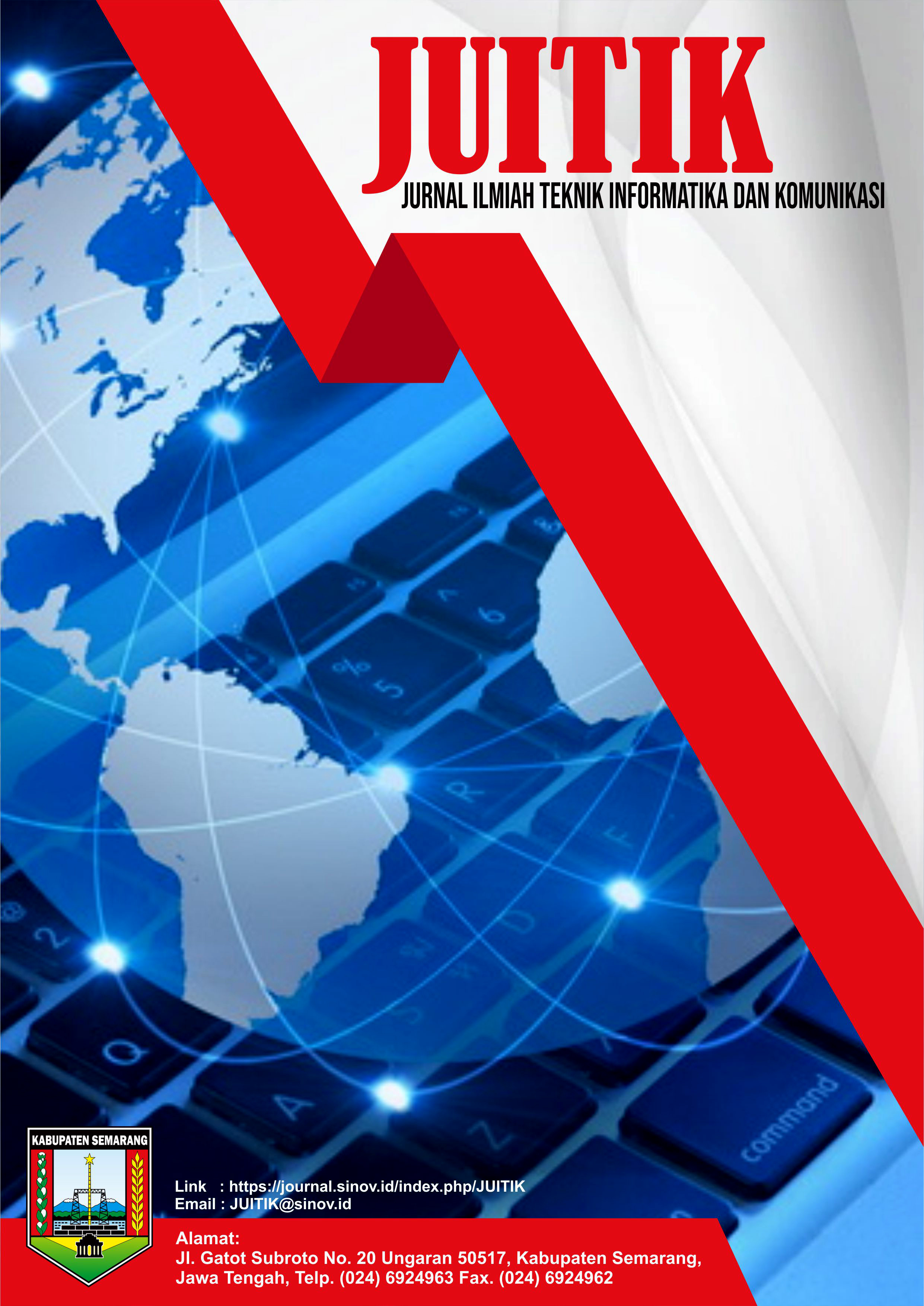Sistem Pendeteksi Penyakit Jantung Berbasis Kecerdasan Buatan Menggunakan Metode Random Forest
DOI:
https://doi.org/10.55606/juitik.v5i1.1330Keywords:
Artificial Intelligence, heart disease, Random ForestAbstract
This research focuses on the development of an early detection system for heart disease using Artificial Intelligence (AI) and the Random Forest method. Heart disease, particularly coronary heart disease (CHD), is a leading cause of death worldwide, with early detection being a crucial factor in reducing mortality rates. The study uses a dataset from the UCI Machine Learning Repository, consisting of 303 patient records with various medical factors like age, sex, cholesterol levels, and blood pressure. The Random Forest algorithm is employed to create a predictive model capable of classifying whether an individual is at risk for heart disease. Data preprocessing, including normalization and encoding categorical variables, is carried out before training the model. The system achieved a high accuracy rate of 98.5% in predicting heart disease risk. The developed model is deployed as an API and can be integrated into healthcare applications for real-time risk prediction, supporting timely medical decisions. This system aims to contribute to the improvement of early heart disease detection, offering an efficient tool for healthcare professionals.
References
Afandi, A. R., & Kurnia, H. (2023). Revolusi Teknologi: Masa Depan Kecerdasan Buatan (AI) dan Dampaknya Terhadap Masyarakat. Academy of Social Science and Global Citizenship Journal, 3(1), 9–13. https://doi.org/10.47200/aossagcj.v3i1.1837
Alfajr, N. H., & Defiyanti, S. (2024). METODE RANDOM FOREST DAN PENERAPAN PRINCIPAL COMPONENT ANALYSIS ( PCA ). 12(3).
All, K., Not, D., & Regression, L. (2006). () Regression 1 / 13. 50(x), 1–13.
Atmojo, J. T., Ningrum, A. N., Handayani, R. T., Widiyanto, A., & Darmayanti, A. T. (2024). Artificial Intelligence dalam Praktik Kesehatan. Jurnal Ilmiah Permas: Jurnal Ilmiah STIKES Kendal, 14(3), 1081–1088. http://journal.stikeskendal.ac.id/index.php/PSKM
Elektronik, J., Udayana, I. K., Getrudis, S., Sadipun, I., Anom, G. N., Putra, C., Cs, M., Raya, J., & Unud, K. (2023). Analisis Algoritma Random Forest Dalam Memprediksi Penyakit Jantung Koroner. 11(4), 2654–5101. https://www.kaggle.com/datasets/johnsmith88/heart-disease-dataset
Haldy, J., & Meily Kurniawidjaja, L. (2024). Faktor Risiko Penyakit Kardiovaskular pada Pekerja : A Systematic Review. Jurnal Kesehatan Masyarakat, 8(1), 47–59.
Jalan, K., Jamilah, N., Umar, S. M., & Ramba, J. (2024). Penerapan Algoritma C4 . 5 dan Random Forest untuk Pemetaan. 7, 326–339.
Nurrohman, S. H., & Kurniawan, D. (2025). Deteksi Dini Risiko Penyakit Jantung Koroner Menggunakan Algoritma Decision Tree dan Random Forest. 6(4), 2582–2593. https://doi.org/10.47065/bits.v6i4.7029
Nuryani, N., Purnama, B., Legowo, B., Utari, U., Riyatun, R., Suharno, S., Yunianto, M., & Lestari, W. (2023). Diseminasi Riset Kecerdasan Buatan Untuk Diagnosis Medis Berbasis Elektrokardiogram di Universitas Duta Bangsa. SEMAR (Jurnal Ilmu Pengetahuan, Teknologi, Dan Seni Bagi Masyarakat), 12(2), 175. https://doi.org/10.20961/semar.v12i2.75521
Pashar, I., Rahmi, Y. O., & Islamiyah, T. (2025). MANUSIA DAN KESEHATAN Faktor-Faktor Risiko Terjadinya Penyakit Jantung Koroner Risk Factors For Coronary Heart Disease In Productive Age. 8, 174–184.
Rahmawati, A., Jayanti, K. D., Bisono, E. F., & Pangestuti, A. (2025). Prediksi Penyakit Gagal Jantung Tahun 2025-2028 Rawat Inap di RSUD Gambiran Kota Kediri Institut Ilmu Kesehatan Bhakti Wiyata Kediri , Indonesia Data PKL mahasiswa IIK Bhakti Wiyata pada Triwulan 4 tahun 2023 di RSUD 10 besar penyakit rawat inap dengan 20. 3.
Sanhaji, G., & Hizbullah, A. I. (2023). Pemanfaatan Artificial Intelligence Dalam Bidang Kesehatan. EDUSAINTEK: Jurnal Pendidikan, Sains Dan Teknologi, 11(1), 234–242. https://doi.org/10.47668/edusaintek.v11i1.999
Santosa, W. N., & Baharuddin, B. (2020). Penyakit Jantung Koroner dan Antioksidan. KELUWIH: Jurnal Kesehatan Dan Kedokteran, 1(2), 98–103. https://doi.org/10.24123/kesdok.v1i2.2566
Schonlau, M., & Zou, R. Y. (2020). The random forest algorithm for statistical learning. Stata Journal, 20(1), 3–29. https://doi.org/10.1177/1536867X20909688
Setyadin, D., Winasis, R. H., & Triyono, G. (2025). Deteksi Berita Palsu menggunakan Algoritma Random Forest Fake News Detection using the Random Forest Algorithm. 14, 1142–1153.
Sobron, M., & Lubis. (2021). Implementasi Artificial Intelligence Pada System Manufaktur Terpadu. Seminar Nasional Teknik (SEMNASTEK) UISU, 4(1), 1–7. https://jurnal.uisu.ac.id/index.php/semnastek/article/view/4134
Trenggono, P. H., & Bachtiar, A. (2023). Peran Artificial Intelligence Dalam Pelayanan Kesehatan : a Systematic Review. Jurnal Ners, 7(1), 444–451. https://doi.org/10.31004/jn.v7i1.13612
Wahyudi, T. (2023). Studi Kasus Pengembangan dan Penggunaan Artificial Intelligence (AI) Sebagai Penunjang Kegiatan Masyarakat Indonesia. Indonesian Journal on Software Engineering (IJSE), 9(1), 28–32. https://ejournal.bsi.ac.id/ejurnal/index.php/ijse
Wijaya, M., Tumbelaka, L. G., & Bandana, V. (2025). KORONER DAN ARITMIA MELALUI MEDIA SOSIAL INSTAGRAM DAN YOUTUBE. 03(01), 1–10.
Downloads
Published
How to Cite
Issue
Section
License
Copyright (c) 2025 Jurnal Ilmiah Teknik Informatika dan Komunikasi

This work is licensed under a Creative Commons Attribution-ShareAlike 4.0 International License.










